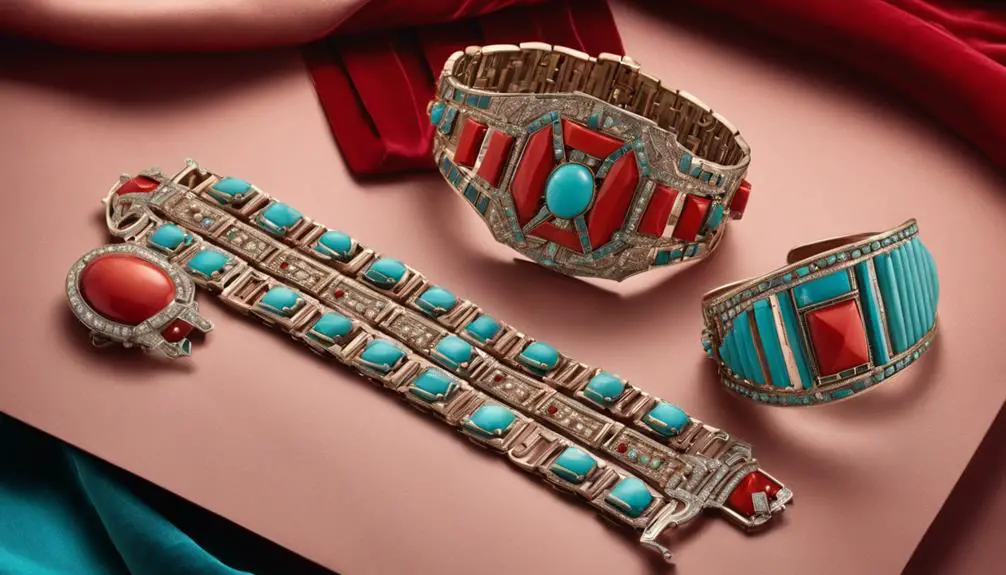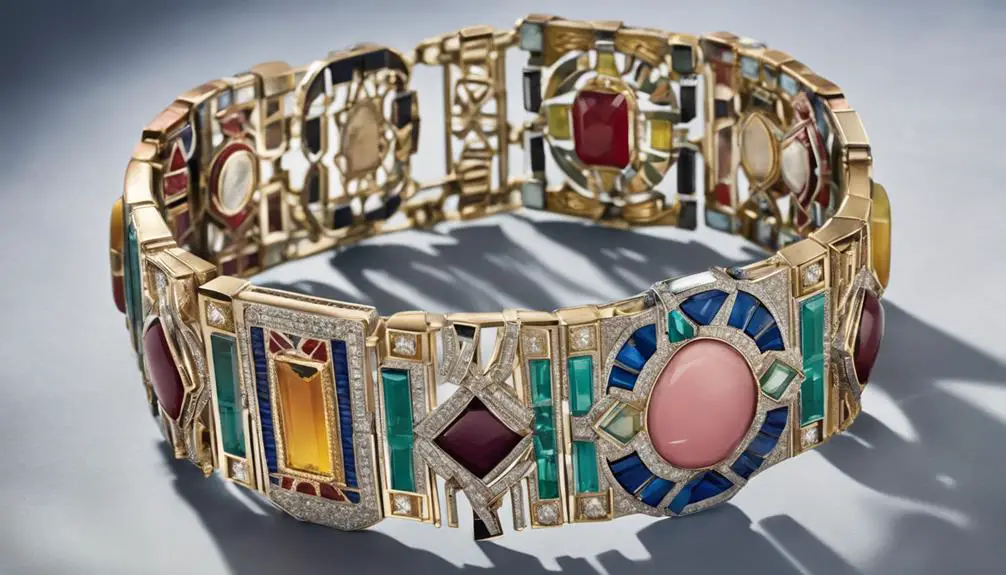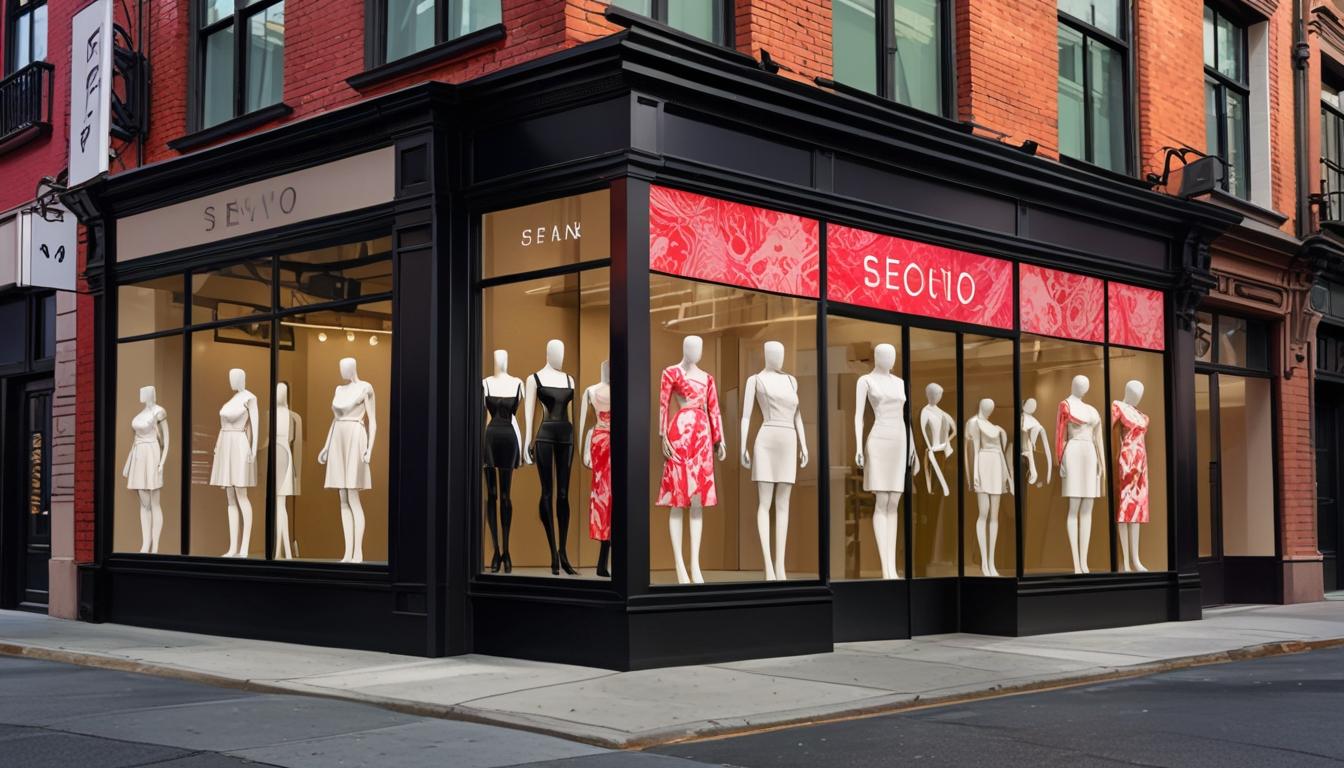In the 1940s, women's Art Deco bracelets blended elegance with resilience, reflecting the era's complexities. These pieces featured bold geometric shapes and intricate craftsmanship, often incorporating gold, silver, and vibrant enamel. Following World War II, materials became scarce, driving innovation and creativity. High-quality natural stones, like sapphires and rubies, added luxe appeal. Influential designers like Cartier and Van Cleef & Arpels transformed bracelets into symbols of status and femininity. This jewelry not only showcased artistry but also mirrored the evolving cultural landscape, marking a significant chapter in women's fashion. You'll discover even more fascinating details about this remarkable period ahead.
Historical Context of Art Deco

The Art Deco movement, which emerged in the 1920s, represents a fascinating intersection of modernism and luxury that profoundly influenced design, particularly in jewelry. This era, characterized by bold colors, geometric patterns, and the use of luxurious materials, set the stage for the creation of vintage Art Deco bracelets that became iconic symbols of elegance. As you investigate the historical context, you'll see how Art Deco not only reflected the opulence of the Roaring Twenties but also adapted in response to the tumultuous events of the 1940s.
The onset of World War II brought about significant changes in design, as the availability of precious resources dwindled. Art Deco jewelry evolved, incorporating more streamlined silhouettes and innovative uses of synthetic stones and alternative metals. Despite these challenges, the bracelets of this era continued to embody resilience and femininity, showcasing gemstones like diamonds, sapphires, and rubies. In a time marked by global conflict, these vintage Art Deco bracelets became a reflection of the enduring spirit of women, symbolizing both elegance and strength amid adversity. This rich historical backdrop makes the study of Art Deco jewelry not just an exploration of style, but a reflection of societal shifts.
Design Elements and Characteristics
Art Deco bracelets from the 1940s showcase an enchanting blend of bold geometric shapes and intricate craftsmanship that reflect the era's architectural influences. You'll notice the striking designs often emphasize symmetry and balance, resulting in pieces that are both visually enthralling and sophisticated. Many of these bracelets, like the Art Deco diamond bracelet, skillfully incorporate a mix of materials such as gold, silver, and vibrant enamel, creating a dynamic contrast in color and texture.
A hallmark of this period is the intricate filigree detailing, where delicate patterns enhance the overall elegance of each piece. This meticulous craftsmanship allows the bracelets to radiate a sense of luxury and refinement. You'll find that the use of natural stones, such as sapphires and rubies, adds to the luxurious feel while staying true to the characteristic style of the time.
Popular Materials and Gemstones

Emphasizing elegance and craftsmanship, popular materials and gemstones in 1940s Art Deco bracelets play an essential role in defining their allure. Gold, silver, and platinum dominated the metal choices, reflecting the era's penchant for luxurious yet durable options. These metals served as the perfect backdrop for stunning Deco diamond and sapphire combinations, where diamonds were often meticulously set in intricate designs to enhance their brilliance.
Colorful enamel work emerged as a popular technique, introducing vibrant hues that allowed for personalized expressions within the rigid geometric patterns typical of the Art Deco style. Natural stones like moonstone and pearls added a softer contrast to the bold metallic elements, enhancing the overall aesthetic and providing depth to the designs.
The filigree technique remained a hallmark of craftsmanship during this period, showcasing delicate patterns that embodied the artistic flair of the movement. Whether you were drawn to a striking Deco diamond or the rich allure of sapphire, each bracelet told a unique story through its materials and gemstones, making them treasured pieces that celebrated both beauty and artistry in jewelry design.
Influential Designers of the Era
Throughout the 1940s, influential designers like Cartier and Van Cleef & Arpels consistently shaped the Art Deco movement with their innovative bracelet creations. Their luxurious designs often featured geometric patterns and bold colors, embodying the spirit of the era. Cartier's ability to blend traditional craftsmanship with modern aesthetics set a benchmark, while Van Cleef & Arpels introduced whimsical elements that captured the imagination.
Tiffany & Co. also garnered acclaim during this period, renowned for meticulous attention to detail and the use of high-quality materials like platinum and diamonds. Their Art Deco bracelets exemplified elegance, reflecting the post-war optimism that characterized the decade.
Additionally, Georg Jensen's work integrated Scandinavian influences, merging organic forms with Deco elements, showcasing functional design without sacrificing beauty. The era also nurtured lesser-known artisans who experimented with materials like synthetic stones and colored enamels, pushing the boundaries of Art Deco bracelets and inviting fresh perspectives.
These designers not only created beautiful pieces but also set the stage for the evolution of jewelry design, marking a transformative time where Art Deco flourished and redefined elegance in women's accessories.
Cultural Impact and Significance

The innovative designs of influential jewelry houses not only defined the aesthetic of the 1940s but also mirrored the cultural zeitgeist of the time. As women emerged from the shadows of World War II, they sought to express their resilience and optimism through fashion. Art Deco bracelets, adorned with diamonds and vibrant colors, became symbols of luxury and freedom, paralleling the post-war desire for elegance.
These stunning pieces featured bold geometric shapes and intricate metalwork, emphasizing both the craftsmanship and the status of the wearer. You can see the impact of these designs in the table below, which highlights key attributes of 1940s Art Deco bracelets:
| Feature | Description | Cultural Significance |
|---|---|---|
| Use of Diamonds | Featured prominently in designs | Symbol of wealth and status |
| Color Palette | Vibrant hues and contrasts | Emblematic of modernity |
| Geometric Shapes | Bold and innovative | Expression of freedom |
| Craftsmanship | Intricate metalwork | Highlight of artistic skill |
| Versatility | Suitable for casual/formal wear | Reflects evolving women's roles |
In this way, 1940s Art Deco bracelets not only adorned wrists but also encapsulated a transformative era in society.
Collecting and Valuing Vintage Bracelets
Collecting vintage bracelets, particularly those from the Art Deco era, has become an enthralling pursuit for many jewelry enthusiasts and investors alike. The value of these exquisite pieces can range dramatically, from about $1,450 to an impressive $55,000. This variance often hinges on materials and craftsmanship, with high-quality gemstones like diamonds, synthetic sapphires, and rubies greatly boosting market worth.
Notable brands such as Cartier and Tiffany & Co. are especially coveted, with their vintage offerings often commanding premium prices. On average, you might expect to pay around $7,485 for a vintage Art Deco bracelet, a reflection of their desirability among collectors.
Unique designs, particularly those featuring intricate filigree diamond work, are especially prized. These pieces not only reflect the exceptional craftsmanship of the Art Deco era but also tell a story of artistic innovation. When evaluating a bracelet, consider its condition, brand, and the uniqueness of its design. Ultimately, understanding these factors will aid you in making informed choices as you navigate the fascinating world of vintage bracelet collecting.
Frequently Asked Questions
What Is Art Deco Bracelet?
An Art Deco bracelet's a striking accessory, showcasing geometric shapes, vibrant colors, and intricate designs. You'll find materials like gold and diamonds, reflecting the era's focus on craftsmanship and bold artistic expression.
When Was the Art Deco Jewelry Period?
The Art Deco jewelry period primarily flourished from the 1920s to the 1930s. You'll notice its bold geometric designs and vibrant colors, reflecting a dynamic shift in artistic expression that influenced various creative fields globally.




